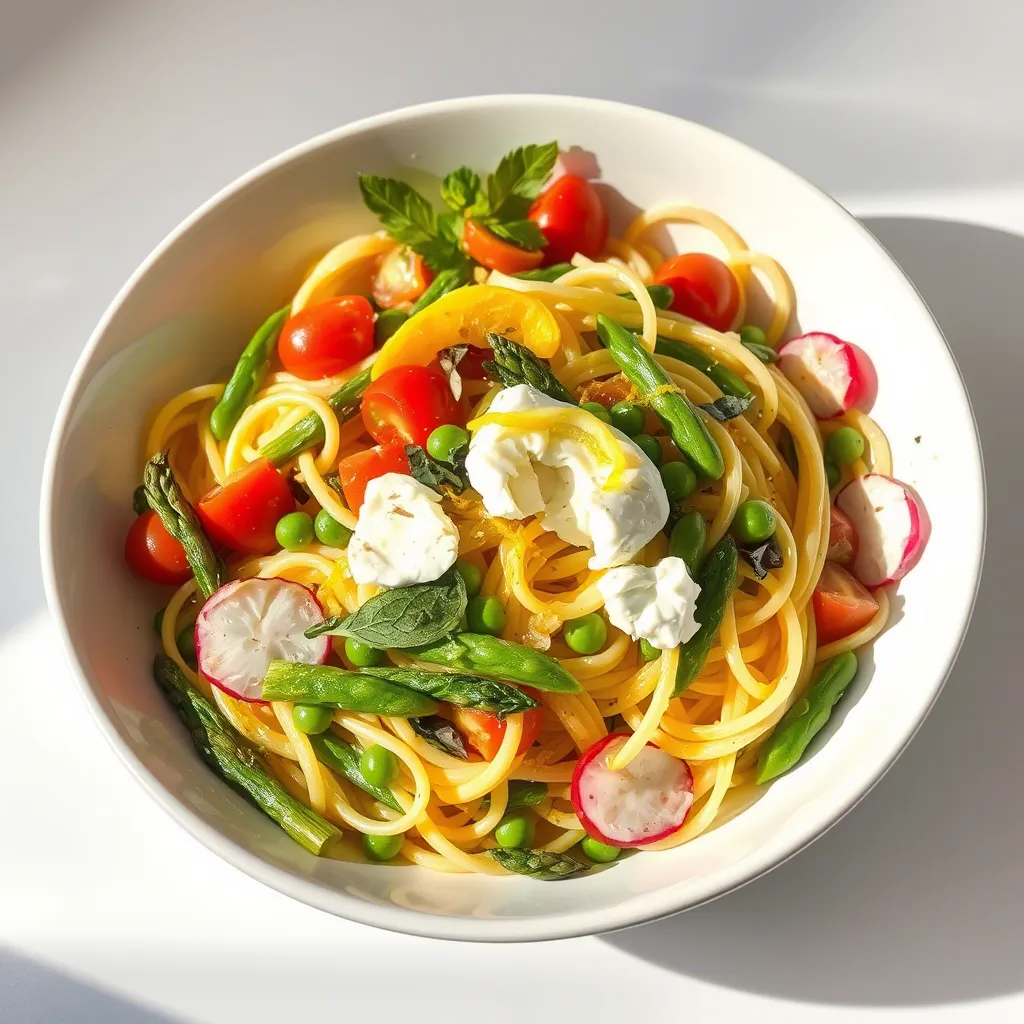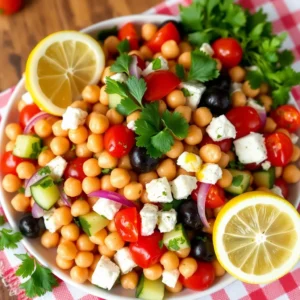Why You’ll Love This Spring Pasta Primavera
There’s something magical about that first bite of Spring Pasta Primavera, when the bright lemon notes dance with the fresh herbs and tender spring vegetables. As a busy mom or working professional, I know weeknight dinners can feel like a chore rather than a celebration. But this recipe? It’s my secret weapon for those evenings when the clock seems to be ticking faster than usual.
You know those moments when you open the refrigerator, hoping inspiration will leap out at you? That’s where this pasta primavera shines brightest. With just 20 minutes of prep time and another 20 minutes of cooking, you’ll have a vibrant, nutrient-packed dinner that doesn’t skimp on flavor or satisfaction. Better yet, it’s endlessly adaptable to whatever vegetables are hanging out in your crisper drawer.
What makes this Spring Pasta Primavera truly special is its ability to please everyone at the table. Even the pickiest eaters tend to find something to love here. Maybe it’s the sweet snap peas or the tender asparagus tips. Perhaps it’s the way the garlic-infused olive oil coats each strand of pasta, creating the perfect backdrop for those spring vegetables to shine.
The beauty of this dish lies in its simplicity. You don’t need fancy techniques or hard-to-find ingredients to create something extraordinary. Instead, this recipe celebrates the natural flavors of spring vegetables at their peak. It’s a reminder that sometimes, the simplest dishes are the most memorable.
Have a vegetarian in the family? This pasta primavera has you covered. Need to accommodate a dairy sensitivity? Just skip the Parmesan or substitute nutritional yeast. Gluten concerns? Swap in your favorite gluten-free pasta, and you’re good to go. It’s the chameleon of dinner recipes, adapting to your family’s needs without sacrificing an ounce of flavor.
And let’s talk leftovers—because with our packed schedules, a recipe that performs double-duty is worth its weight in gold. This spring pasta is even better the next day, when the herbs and lemon have had time to infuse every bite. Pack it in a lunch container, and you’ve got tomorrow’s envy-inducing office lunch sorted.
The Story Behind This Spring Pasta Primavera
The first time I made this Spring Pasta Primavera, I was knee-deep in what my family now refers to as “The Great Recipe Rut of 2019.” You know the feeling—cooking the same five dishes on rotation until even your favorite meals start to lose their luster. We needed something fresh, something that tasted like sunshine on a plate.
It was early April, and the farmers’ market had just begun to showcase those first tender vegetables of spring. There were bundles of asparagus with tips so tight they looked like they were standing at attention. Peas still in their pods, waiting to be shelled like nature’s own fidget toy. And herbs—oh, the herbs!—bursting with oils and fragrance that no grocery store version could match.
I gathered an armful of spring’s bounty, not yet knowing what I’d create, but certain that whatever it was would break us out of our dinner doldrums. Back in my kitchen, with the window cracked open to let in that fresh spring breeze, inspiration struck. Pasta primavera—quite literally “spring pasta”—was exactly what we needed.
My first attempt was good, but not quite there. The vegetables were properly crisp-tender, but something was missing. That’s when my youngest wandered into the kitchen, plucked a lemon from our fruit bowl, and asked, “Can we use this?” That child deserves a culinary medal, because that lemon was exactly what the dish needed—brightness to cut through the olive oil and wake up all those spring flavors.
Now, this recipe has become something of a tradition in our house. When those first spring vegetables appear, my kids actually cheer for “that lemon pasta with the green stuff,” which, if you’re a parent, you know is high praise indeed. I’ve made it for dinner parties where friends have demanded the recipe before the meal was even over. I’ve taught my sister to make it over FaceTime, talking her through each step as her confidence in the kitchen grew.
But my favorite memory of this dish comes from a particularly challenging Wednesday last spring. Work deadlines were piling up, the kids had activities pulling us in different directions, and I almost resorted to takeout. Instead, I took a deep breath and reached for this recipe. Twenty minutes later, we gathered around the table, the steam from the pasta carrying the scent of herbs and lemon up to our faces. For fifteen precious minutes, we slowed down, savored each bite, and reconnected. That’s the power of a good meal—it can transform even the most chaotic day into something special.
If you’re looking for another spring favorite, my Cucumber Tomato Salad makes the perfect light side dish to complement this pasta.
Ingredients
The beauty of this Spring Pasta Primavera is how it celebrates simple, fresh ingredients. Each component plays an important role in creating a harmonious dish that’s greater than the sum of its parts. Let’s break down what you’ll need:
For the Pasta Base:
- 12 ounces of pasta (I prefer fettuccine or linguine, but penne or farfalle work beautifully too)
- 2 tablespoons of high-quality olive oil (this is where that bottle you’ve been saving for “special occasions” comes into play)
- 3 cloves of garlic, minced (not the pre-minced stuff in jars—trust me on this one)
- 1 small shallot, finely diced (its delicate sweetness is worth the extra chopping)
- ½ teaspoon red pepper flakes (adjust according to your spice tolerance)
- ½ cup reserved pasta water (this starchy liquid is liquid gold for creating a silky sauce)
For the Spring Vegetables:
- 1 bunch asparagus (about 1 pound), woody ends trimmed, cut into 2-inch pieces
- 1 cup fresh or frozen peas (if using fresh, you’ll need about 1 pound of pods to shell)
- 1 medium zucchini, quartered lengthwise and sliced (adds a lovely texture contrast)
- 1 cup cherry tomatoes, halved (yes, technically a fruit, but they bring gorgeous color and acidity)
- 1 cup thinly sliced radishes (for that peppery crunch and pop of color)
For the Bright Finish:
- Zest and juice of 1 large lemon (organic if possible, since you’re using the zest)
- ¼ cup fresh herbs, chopped (a mix of basil, parsley, chives, and mint works wonderfully)
- ⅓ cup grated Parmesan cheese, plus more for serving (the real stuff, please—pre-grated won’t melt properly)
- 2 tablespoons unsalted butter (for that final glossy finish)
- Salt and freshly ground black pepper to taste
What makes this ingredient list special is its flexibility. Don’t have zucchini? Substitute yellow summer squash. No cherry tomatoes? Skip them or use sun-dried tomatoes for a different flavor profile. The recipe is forgiving and adaptable to what you have on hand or what looks best at the market.
When it comes to the pasta itself, don’t feel limited to wheat varieties. This dish works beautifully with gluten-free alternatives, especially those made from rice or corn which hold their texture well. For a protein boost, consider chickpea or lentil pasta—they add a nutty flavor that complements the spring vegetables wonderfully.
The herbs are where you can really make this dish your own. While I’ve suggested a mix, feel free to lean heavily on your favorites. Basil brings a sweet, aromatic quality, while mint adds unexpected freshness. Parsley provides a clean backdrop, and chives contribute a mild onion note. Whatever combination you choose, use them generously—herbs are the heart and soul of this spring pasta.
For the Parmesan, I strongly recommend buying a block and grating it yourself. Pre-grated cheese often contains anti-caking agents that prevent it from melting smoothly into your sauce. According to Serious Eats, freshly grated Parmesan melts at a lower temperature and creates a silkier sauce than its pre-grated counterpart.
Execution
Creating this Spring Pasta Primavera is less about technical skill and more about timing and attention. The goal is to cook the pasta perfectly al dente while preparing the vegetables so they retain their vibrant colors and crisp-tender textures. Ready to dive in? Let’s break it down step by step:
Step 1: Prep Your Ingredients (5 minutes) Before you turn on a single burner, take a few minutes to get organized. Wash and chop all your vegetables, mince your garlic, dice your shallot, and measure remaining ingredients. This mise en place (fancy chef-speak for “everything in its place”) will make the cooking process smooth and stress-free.
Step 2: Start Your Pasta Water (3 minutes) Fill a large pot with water, adding approximately 1 tablespoon of salt per gallon of water. Don’t skimp on salt here—it’s your only chance to season the pasta itself. Bring the water to a rolling boil over high heat.
Step 3: Blanch the Asparagus (2 minutes) While waiting for your pasta water to boil, prepare an ice bath (a large bowl of water with ice cubes). Once the water is boiling, add the asparagus pieces and blanch for just 60-90 seconds until bright green but still firm. Using a slotted spoon, transfer them immediately to the ice bath to stop the cooking process. Once cooled (about 1 minute), drain and set aside.
Step 4: Cook the Pasta (8-10 minutes) Add your pasta to the same boiling water you used for the asparagus. Cook according to package directions for al dente texture, usually 8-10 minutes. Before draining, remember to reserve ½ cup of the starchy pasta water—this will help create your silky sauce later.
Step 5: Sauté the Aromatics (3 minutes) While the pasta cooks, heat olive oil in a large skillet over medium heat. Add the minced garlic, diced shallot, and red pepper flakes. Sauté until fragrant and translucent but not browned, about 2-3 minutes. If the garlic starts to brown, reduce your heat—bitter burnt garlic is the fastest way to ruin this dish!
Step 6: Add the Vegetables (5 minutes) Add the zucchini slices to the skillet and cook for 2 minutes. Then add the blanched asparagus, peas (no need to defrost if using frozen), cherry tomatoes, and sliced radishes. Sauté for just 2-3 minutes more—you want the vegetables tender but still with some bite. Season with a pinch of salt and pepper.
Step 7: Combine and Create the Sauce (2 minutes) Add the drained pasta directly to the skillet with the vegetables. Pour in the lemon juice and about half of the reserved pasta water. Toss everything together, allowing the starchy water to create a light sauce that coats each strand of pasta. If it seems too dry, add more pasta water, a tablespoon at a time.
Step 8: The Final Touch (1 minute) Remove the skillet from heat and immediately add the butter, grated Parmesan, lemon zest, and most of the fresh herbs (save some for garnish). Toss quickly until the butter and cheese melt into a glossy finish. Taste and adjust seasoning as needed.
Step 9: Serve and Garnish (1 minute) Transfer your spring pasta primavera to a large serving platter or individual bowls. Sprinkle with the remaining fresh herbs and offer additional Parmesan at the table. For an elegant presentation, add a few edible flowers like nasturtiums or pansies on top—they’re not just pretty, they’re delicious too!
The key to success with this recipe lies in not overcooking the vegetables. Unlike my Hearty Vegetable Soup where long simmering creates deep flavor, here we want to preserve the fresh, vibrant qualities of spring produce.
Additional Tips
The beauty of this Spring Pasta Primavera lies in its versatility and forgiving nature, but a few extra tips and tricks can elevate it from delicious to absolutely memorable. Let’s dive into some ways to make this dish truly your own!
Perfect Pasta Selection While I’ve suggested long pasta like fettuccine or linguine, don’t be afraid to experiment. Orecchiette (“little ears”) are perfect for catching peas in their gentle curves. Rotini’s spirals grip the sauce beautifully. And if you’re feeling ambitious, fresh homemade pasta creates an entirely different experience—softer, more delicate, and incredibly satisfying. For a truly authentic approach, try homemade pasta primavera with fresh pasta made from scratch.
Seasonal Adaptations Spring vegetables are the traditional stars of pasta primavera, but this dish can evolve with the seasons:
- Summer: Swap in corn kernels, cherry tomatoes, and yellow squash
- Fall: Try roasted butternut squash, sage, and toasted walnuts
- Winter: Consider roasted Brussels sprouts, caramelized onions, and pancetta
Make-Ahead Strategies For busy weeknights, prep components in advance:
- Blanch asparagus and store in the refrigerator (up to 2 days)
- Chop herbs and store between damp paper towels (up to 3 days)
- Mince garlic and shallots, storing them separately in the refrigerator (up to 2 days)
Storage Solutions This pasta primavera keeps beautifully for 3-4 days in the refrigerator. Store it in an airtight container, and when reheating, add a splash of water or broth to revive the sauce. The flavors often deepen overnight, making day-two pasta primavera something to look forward to!
Protein Additions While this dish shines as a vegetarian option, it’s easily customizable for omnivores:
- For seafood lovers: Add 1 pound of sautéed shrimp or scallops
- For poultry fans: Include 2 cups of shredded rotisserie chicken
- For meat enthusiasts: Crisp up 4 ounces of pancetta or bacon before adding the vegetables
Perfect Pairing Suggestions Complete your meal with thoughtful accompaniments:
- Bread: A crusty baguette or herbed focaccia for sopping up any leftover sauce
- Wine: A crisp Sauvignon Blanc or light Pinot Grigio complements the lemony notes
- Dessert: Keep it light with berries and lemon sorbet to maintain the spring theme
Troubleshooting Common Issues Even the best cooks encounter challenges. Here’s how to address potential problems:
- Watery sauce: Allow excess pasta water to evaporate before adding butter and cheese
- Overcooked vegetables: Refresh them under cold water, then briefly rewarm in the final toss
- Clumpy cheese: Remove the pan from heat before adding Parmesan, and make sure it’s finely grated
Environmental Considerations Reduce food waste with these eco-friendly approaches:
- Use asparagus stems in vegetable stock instead of discarding them
- Save Parmesan rinds in the freezer to flavor future soups and sauces
- Compost any herb stems or vegetable trimmings
According to The Kitchn, Americans throw away nearly 40% of their food. By thoughtfully using all parts of your ingredients, you’re not just saving money—you’re also helping the planet.
FAQs
Can I make this Spring Pasta Primavera ahead of time for a dinner party? Absolutely, but with a strategic approach. Prep all components separately: blanch the vegetables, cook the pasta (slightly underdone), and prepare the aromatics. Store everything separately in the refrigerator. About 15 minutes before serving, combine everything in a large skillet, adding a splash of pasta water or broth to create the sauce. This method gives you the fresh taste of just-made pasta primavera without the last-minute cooking stress.
Is this vegetable primavera suitable for vegetarians and vegans? The recipe as written is perfect for vegetarians. For vegans, simply omit the Parmesan and butter, substituting nutritional yeast for cheesy flavor and a good-quality olive oil for richness. The herb pasta’s bright flavors shine through even without dairy components, making it a versatile option for mixed dietary preferences.
How can I boost the protein content in this spring pasta dish? Beyond the protein additions mentioned in the tips section, consider plant-based options like cannellini beans, toasted pine nuts, or crispy tofu cubes. For a Mediterranean twist, add chickpeas tossed with a little extra lemon zest and olive oil. These additions maintain the dish’s light character while increasing its staying power.
My kids don’t like “green things” in their pasta. Any suggestions? The struggle is real! Try these kid-friendly adaptations: chop herbs very finely so they’re less visually prominent, focus on sweeter vegetables like peas and carrots instead of asparagus, or create a “build your own pasta primavera” bar where kids can choose their own vegetable additions. Often, involvement in the decision-making process increases acceptance of new foods.
Can I freeze this spring vegetable pasta? While you can freeze it, the texture of the vegetables and the integrity of the sauce may suffer upon thawing. If you must freeze, do so without the herbs, adding fresh ones after reheating. To revive frozen pasta primavera, thaw in the refrigerator overnight, then gently reheat in a skillet with a splash of broth, finishing with a drizzle of olive oil for freshness.
What’s the difference between pasta primavera and regular vegetable pasta? Pasta primavera specifically celebrates spring vegetables (“primavera” means “spring” in Italian) and traditionally features a lighter sauce based on olive oil rather than tomatoes or cream. The emphasis is on highlighting fresh, seasonal produce with minimal cooking to preserve bright flavors and colors. A regular vegetable pasta might use any combination of vegetables in any sauce base.
How can I make this recipe gluten-free without losing flavor? Choose high-quality gluten-free pasta made from rice, corn, or a blend (these hold their shape better than purely rice-based options). Cook it 1-2 minutes less than package directions since you’ll be finishing it in the skillet. The vibrant vegetables, herbs, and lemon-based sauce ensure you won’t miss any flavor, even without traditional wheat pasta.
Spring pasta has been a staple in Italian-American cuisine since the 1970s when it was popularized at Le Cirque restaurant in New York. Our version stays true to those bright, fresh roots while incorporating modern techniques and ingredient flexibility. Whether you’re cooking for a busy weeknight dinner or a special occasion, this Spring Pasta Primavera with Lemon and Herbs delivers restaurant-quality results with home-kitchen simplicity. The combination of perfectly al dente pasta, crisp-tender vegetables, and that aromatic herb-lemon finish creates a dish that feels like sunshine on a plate—exactly what we all need as winter finally releases its grip and spring unfolds in all its glory.



